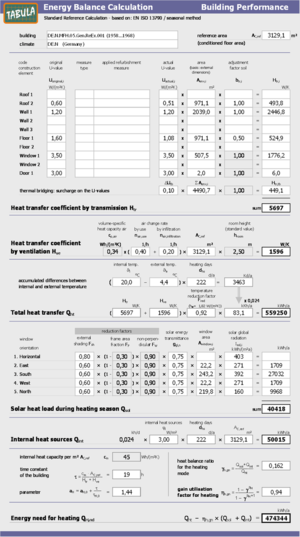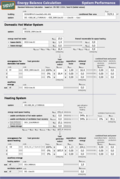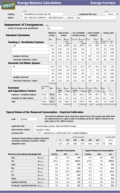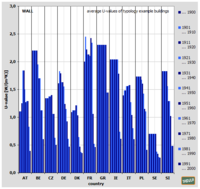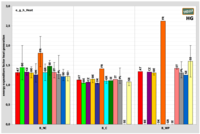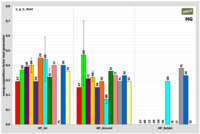- >
- Building Typology>
- TABULA Typology Structure>
- Common Calculation Procedure
Common Calculation Procedure
for Cross-Country Comparisons
Overview
During the IEE project TABULA a common calculation procedure was designed to compare the energy performance of exemplary buildings from different countries. The method consists of
- a harmonised data structure which is the foundation of a building data base;
- a standard reference calculation procedure for determining the heat need and the delivered energy demand;
- a scheme for assessing the calculated energywares in terms of primary energy, carbon dioxide emis-sions and heating costs;
- a scheme for adapting the calculated energy use to the level of energy consumption which is typical for the respective building types and energy performance levels of the different countries.
The method is focused on the energy use for space heating and domestic hot water of residential buildings. Cooling, air conditioning, lighting, electric appliances are until now not considered in the concept but can of course later be supplemented.
The TABULA maxim is to image the relevant parameters determining the energy consumption of a building in a realistic way and to keep at the same time the method as simple as possible. In consequence, averages are used when applicable, which of course can be determined by more detailed methods.
The objective of simplification is to ensure transparency of the calculation, so that the procedure is easily traceable by experts from different countries. It is also the precondition for an easy handling of the calculation of large numbers of building datasets (e.g. by use of Excel spreadsheets).
In the framework of the IEE project TABULA an Excel workbook "TABULA.xlsm" (access information on page Download) was developed which consists of two tables for the row-by-row calculation of the building and supply system balance and about 60 referenced tables with constant and variable input data (e.g. construction element types by construction year classes including U-values, heat generator types including energy expenditure factors, …). A simplified version "tabula-calculator.xls" which abstains from referenced tables and can therefore easily be used by third parties is available at the website (calculation: tabula-calculator.xlsx; respective data tables: tabula-values.xlsx). In parallel to the Excel workbook a webtool was developed which enables an online calculation according to the TABULA method (TABULA WebTool). In all mentioned tools both can be traced at the same time: the formulas and the current values of the selected building / system combination.
The calculation procedure is defined in accordance with the relevant CEN standards and takes into account standard values for the utilisation as well as national or regional climatic data. The details are documented in TABULA_CommonCalculationMethod.pdf.
Energy Need for Heating
The energy need for space heating is calculated by applying the seasonal method according to EN ISO 13790 on the basis of a one-zone model. The external boundary conditions (air temperature, external temperature / solar radiation) are defined by each partner for his own country for a standard base temperature. In case of significant climatic differences between regions of a country several climate datasets are supposed to be provided. Standard values are used for the utilisation conditions (room temperature, air exchange rate, internal heat sources) and for the solar radiation reduction factors (shading). However, the Excel workbook “TABULA.xlsm” also enables a change of input parameters in the context of national applications which do not imply a comparison with other countries.
Heating System Typology and Assessment of Energywares
The calculation of the supply system is based on tabled values for the different heating and DHW subsystems (approach according to EN 15316, Level B). National experts responsible for elaboration and maintenance of the TABULA typology data of their country determined the respective numbers by applying their national energy performance certificate methods and by converting and entering these values into the TABULA database.
As a further step an assessment of the used energywares is performed by multiplying the delivered energy per energy carrier with the respective national or European factors. It includes the determination of the quantities:
- total primary energy demand,
- non-renewable primary energy demand,
- carbon dioxide emissions,
- energy costs.
The standard reference calculation is calibrated to the typical level of measured consumption - as far as information about the correlation is available for the different countries. The calibration factor describes the ratio of the energy uses determined by measurements for a large number of buildings and the energy uses determined by the TABULA method for the given value of the TABULA method.
Calculation sheet: energy performance of the heat supply system
Standard Reference Calculation - based on: EN ISO 15316 / level B (tabled values)
Basis of the calculation are tabled values for heat generation, storage, distribution and auxiliary energy - each for space heating and domestic hot water. The respective values for these system components have been determined for each country by use of the relevant national EPC methods and entered into the TABULA database.
Comparison of Energy Performance Data
Construction Elements and Insulation Measures
An evaluation of the U-values of roofs, walls, windows and floors of the exemplary buildings provides indications about the development of thermal quality standards in the participating countries during the last century (see figure below). Of course, since the transfer coefficients by transmission were not exactly measured the comparison is not reflecting the actual but the assumed performance relying on individual national assessment methods.
The evaluation of the refurbishment measures on the levels "Standard" and "Advanced", as proposed in different the typology brochures (see Country Pages), disclosed rather large differences – even between countries in similar climatic zones (see second figure below). Thus, the confrontation and discussion of energy upgrade qualities remains an important task for the future.
U-values of exemplary buildings
Analysis of "TABULA.xlsm" data – Comparison of features of exemplary buildings
Example: U-values of walls per country and decade
Evaluations of further envelope types ("roof", "window", "floor") are available at TABULA_WorkReport_EvaluationDatabase.pdf.
Typical and ambitious insulation measures in different countries
Analysis of "TABULA.xlsm" data – Comparison of insulation measures proposed in the national typology brochures (see Country Pages)
Example: insulation thickness of wall refurbishment per country; "standard" (RP1) and "advanced" (RP2) measures
Evaluations of further envelope types ("roof", "window", "floor") are available at TABULA_WorkReport_EvaluationDatabase.pdf.
Energy Performance Values of Heat Supply Systems
Since commonly defined data are available for heat generators, storages and distribution systems a comparison of the energy performance of these components between the participating countries was possible (see exemplary charts below). Generally the values turned out to be rather similar for a given component. In some cases larger deviations were found which may either reflect differences in technologies or in methods for the determination of standard values. In any case such comparisons can also in the future be useful for a quality check of the typology input data.
Examples of supply system values from different countries
Cross-Country Comparison of system data included in TABULA.xlsm (TABULA_WorkReport_EvaluationDatabase.pdf)
Examples: energy expenditure factors of
a) boilers B_NC, B_C, B_WP (non-condensing, condensing and wood pellets) and
b) electrical heat pumps HP_Air, HP_Ground, HP_ExhAir (heat source: external air, ground, exhaust air)
FAQ - Frequently Asked Questions
Dataset identification - codes
Q: Why do I have for the same kind of building three different acronyms with different value especially for the U-value? For example: AT.N.AB.01.Gen.ReEx.001.001- AT.N.AB.01.Gen.ReEx.001.002- AT.N.AB.01.Gen.ReEx.001.003 (Only the last number change)
A: The last number is the variant number of the building. In the common typology concept this is representing the energy performance level 1, 2 and 3, see interpretation for the different countries at the “about page” of the WebTool.
Q: What is the meaning of "ReEx" and "SyAv" on the acronyms? For example "DK.N.AB.01.Gen.ReEx.001.001" and "DK.N.AB.01.Gen.SyAv.001.001"
A: “ReEx” is a code for “real example” and “SyAv” for “Synthetical Average”. The real example buildings are used as showcase examples and can be found in the typology brochures at the country pages of the TABULA/EPISCOPE website episcope.eu/building-typology/country/ as well as in the section “Building Typologies” of the TABULA WebTool. The synthetical average buildings are used for simplified building stock models (see episcope.eu/monitoring/average-buildings/ and section “Building Stocks” of the TABULA WebTool).















